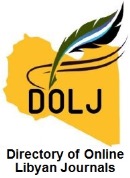تملح الترب الزراعية كأحد إشكاليات التنمية بمنطقة وادي الشاطئ
DOI:
https://doi.org/10.59743/jmset.v3i1.102الكلمات المفتاحية:
التملح، التنمية المستدامة، وادي الشاطئ، ليبياالملخص
استهدفت هذه الدراسة إلقاء الضوء على مدى تأثر الترب الزراعية بمنطقة وادي الشاطئ بمشكلة الملوحة بسبب التنمية الزراعية والظروف المناخية والبيئية السائدة، وقد أظهرت نتائج هذه الدراسة ارتفاع الإيصالية الكهربائية لترب الطبقة السطحية مقارنة بالطبقة السفلية حيث تراوحت هذه القيم ما بين 1.08– 144.67 dS.m-1، بينما كانت أعلى في طبقة القشرة حيث تراوحت ما بين (77.00-195.03 dS.m-1) وذلك بسبب التراكم الشديد للأملاح ، كما بينت النتائج أن حاصل النسبة المحسوبة للعلاقة (3CO3 + HCO / Cl + SO4) كان < 1 مما يدل على إن الترب في طور إدمصاص شديد للصوديوم. وكانت النسبة ما بين الكبريتات/الكلوريدات < 1 لمعظم ترب المنطقة مما يدل على سيادة أملاح الكلوريدات وهذا يعني وصول الترب الى أطوار التملح الأخيرة. كما أظهرت النتائج ارتفاع قيم ESP عن 15% لمعظم الترب (4.4-49.6%) وكانت قيمها بالطبقة السطحية أعلى من السفلية. وبينت النتائج أن 84.4% من إجمالي الترب المدروسة متأثرة بالملوحة (67.5% ترب ملحية - صودية للترب غير المزروعة، 50% من الترب المزروعة)، وقد ساهم الماء الأرضي في تملح تلك الترب بشكل كبير حيث كانت القيم المحسوبة لدليل الملوحة < 1، إضافة إلى ارتفاع منسوبه وقربه من سطح الترب (أقل من العمق الحرج). ويزيد مناخ المنطقة من كمية التبخر بسبب ارتفاع معدلات الحرارة وسرعة الرياح وانخفاض رطوبة الجو النسبية. وكان تدهور الطبقة السطحية للترب أكثر منه في الطبقة السفلية ويظهر ذلك بشكل أكبر في الترب غير المزروعة حيث قدر أقصى معدل للتراكم الفصلي للأملاح بحوالي 124.80 طن/هكتار ووصل أقصى سمك لتلك القشور 5 سم.
التنزيلات
المراجع
قائمة المراجع باللغة العربية
أبوضاحي، يوسف محمد واليونس، مؤيد أحمد (1988). دليل تغذية النبات. جامعة بغداد-العراق.
احمد، عمر اسعد و محمد، عائشة رمضان (2007). تأثير مياه الري على تدهور بعض ترب وادي الشاطئ. مؤتمر الصحارى والتصحر، الواقع وأفاق المستقبل سبها في 19-21/3/2007م، ليبيا
البطيخي، أنور وخطاري سيد (1999). علم التربة مبادئ وتطبيقات، (كتاب مترجم تأليف: هاوزنيولر)، منشورات دار البشير، مؤسسة الرسالة، بيروت، لبنان.
الدومي، محمد فوزي والماحي، يوسف القرشي والحسن، جاد الله عبدالله (1996). طرق تحليل الترب والنباتات والمياه. (كتاب مترجم تأليف: هومر. د. شايمان وباركر. ف. برات) منشورات جامعة عمر المختار، البيضاء، ليبيا.
الدومي، محمد فوزى (2000). علم التربة أساسيات وتطبيقات. (كتاب مترجم تأليف: هاوزنيولر)، منشورات دار البشير، مؤسسة الرسالة، بيروت، لبنان.
الزبيدي، أحمد حيدر (1989). ملوحة التربة، الأسس النظرية والتطبيقية. جامعة بغداد، العراق.
المسماري، صابر السيد منصور والحسابي، سعد عبد محمد (1996). مقدمة في كيمياء المياه الطبيعية. (كتاب مترجم تأليف باكنكويف، غوردن ك)، منشورات جامعة عمر المختار، البيضاء، ليبيا.
المنظمة العربية للتنمية الزراعية (2001). دراسة تقويم الآثار المترتبة على سوء استخدام الموارد المائية غير التقليدية على البيئة الزراعية العربية. جامعة الدول العربية، الخرطوم سبتمبر 2001، السودان.
الهيئة العامة للبيئة (2000). التقرير الوطني الأول للبيئة، طرابلس، ليبيا.
بن محمود، خالد رمضان (1995). الترب الليبية (تكوينها. تصنيفها. خواصها. امكانياتها الزراعية). الهيئة القومية للبحث العلمي، طرابلس، ليبيا.
جامعة الدول العربية، المركز العري لدراسات المناطق الجافه وبرنامج الامم المتحدة للبيئة (اكساد و UNEP) (2004). حالة التصحر في الوطن. دراسة محدثة، دمشق، سوريا.
حسن، قتيبة محمد (1987). العلاقات المائية للنباتات. (كتاب مترجم تأليف : كريمر)، وزارة التعليم العالي والبحث العلمي، جامعة بغداد، بيت الحكمة، العراق.
نسيم، ماهر جورجي (2003). طرق تحليل الأراضي. منشأة المعارف، الاسكندرية، مصر.
محمد، عائشة رمضان (2008). تقييم نوعية مياه الري وملوحة الترب الزراعية بمنطقة وادي لشاطئ. رسالة ماجستير، قسم علوم البيئة، كلية العلوم الهندسية والتقنية، جامعة سبها، براك، ليبيا.
قائمة المراجع باللغة الإنجليزية
Akhter J., Murray K., Mahmood K.A. & Ahmed S. (2004). Improvement of degaded physical proerties of a saline – sodic soil by reclamation with Kallar grass (Leptochloa fusca). Plant and Soil, 258: 207-216.
Ashraf M. (1999). Breeding for Salinity Tolerance Protins in Plant. Critical Reviews in Plant Sciences, 13(1): 17-42.
Bressler E., Mc Neal B., and Carter D.T. (1982). Saline and Sadic Soils. Springler Verlag, Berlin, Germany.
Claridge G.G.C., and Campbell I.B. (1982). A comparison between hot and cold desert soils and soil processes. In Aridic soils and Geomorphic processes ، D.H. Yaalon (Ed.). Catena supplement I. Cremlingen, FRG, 1-29.
Elssaidi M.A. (1998). Laboratory and Field Studies On The Fate of Fenitrothion & Malathion on Micro-Ecosystem Models. M.Sc. Thesis, Environ. Sci. Dept. Fac. Eng. Tech., Sebha University, Libya.
Food & Agriculture Organization (2005). Water Quality Evaluation. Water quality for Agriculture.
Ghaly M.F. (2002). Role of natural vegetation in improving salt affected soil in northern Egypt. Soil and Tillage Research, 64: 173-178.
Hans W.E., Nicole G., Sayed H., and Bernhrd H. (2006). Mecanisms of Cash Crop to Maintain Yields and Reclaim Saline Soils in Arid Areas. Ecophysiology of High Salinity Tolerant Plants, Chapter 22: 345-366.
Houat D.R. (2000). Acceptable Salinity Sodicity and pH Values, for Boreal Forest Reclamation, Alberta Environment. Environment Sciences Division Edmonton Alberta, Report ESD/LM/00-2, Canada.
Kaledhonkar M.J., Keshari A.K., Van der zee S.E.A.T.M. (2006). Relative sensitivity of ESP profile to spatial and temporal variability in cation exchange capacity and pore water velocit under simulated field conditions. Agricultural Water Management, 83: 58-68.
Seatz L.F. and Peterson H.B. (1964). Acid, Alkaline, Saline, and Sodic Soil. Chapter 7 in the Chemistry of the soil, Ed. F. Bear, 2nd ed., A.C.S. Monogram No. 160.
Mishra A., Sharma S.D., and Khan G.H. (2003). Improvement in physical and chemical properties of sodic soil by 3, 6 and 9 years old plantation of some observations with respect to sodicity hazard of irrigation water. Agricultural Water Management, 61: 229-231.
Osman A., Taskin O.W., Salih E., Hasbi Y., and Zeynep N.Y. (2003). Spatial variability of exchangeable sodium, electrical conductivity, soil pH and boron content in salt and sodium-affected areas of the Igdir plain (Turkey). Journal of arid Environments, 54: 495-503.
Richards L.A. (1954). Diagnosis and improvement of saline and alkali soils. USDA Handbook 60,U.S. Government Printing Office, Washington DC, USA.
Szabolcs I. (1974). Salt affected Soils in Europe. Martinus Nijhoff-The Hague, and Research institute For Soil Science and Agriculture, Chemistry of the Hungarian academy of Science, Budapest, Hungary.
Vijendra P.S.S., Ashwani K., and Karl-Hermann N. (2006). Bio-reclamation of secondary salinized soils using Halophytes, Biosaline Agriculture and Salinity Tolerance in Plants. Bio saline Agriculture and Salinity Tolerance in Plants, 147-154.
Zhao K.F. (1999). Desalinization of saline soils by Suaeda salsa. Plant and Soil, 135: 303-305.
التنزيلات
منشور
إصدار
القسم
الرخصة
الحقوق الفكرية (c) 2017 مجلة علوم البحار والتقنيات البيئية

هذا العمل مرخص بموجب Creative Commons Attribution 4.0 International License.












